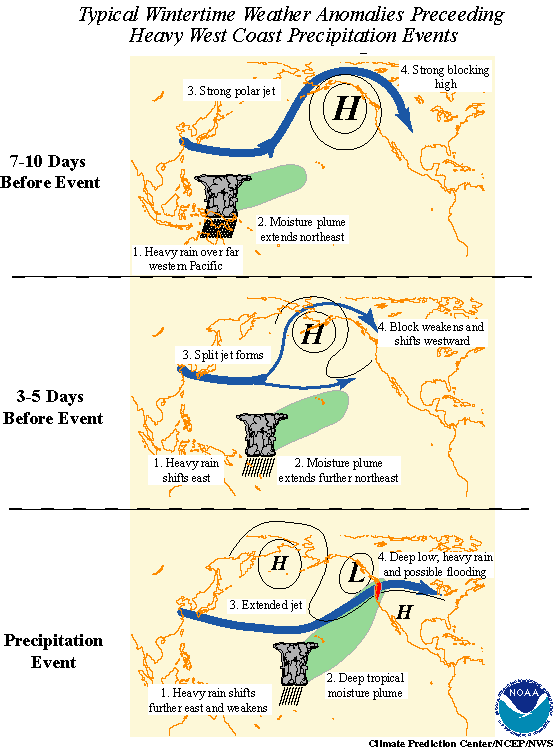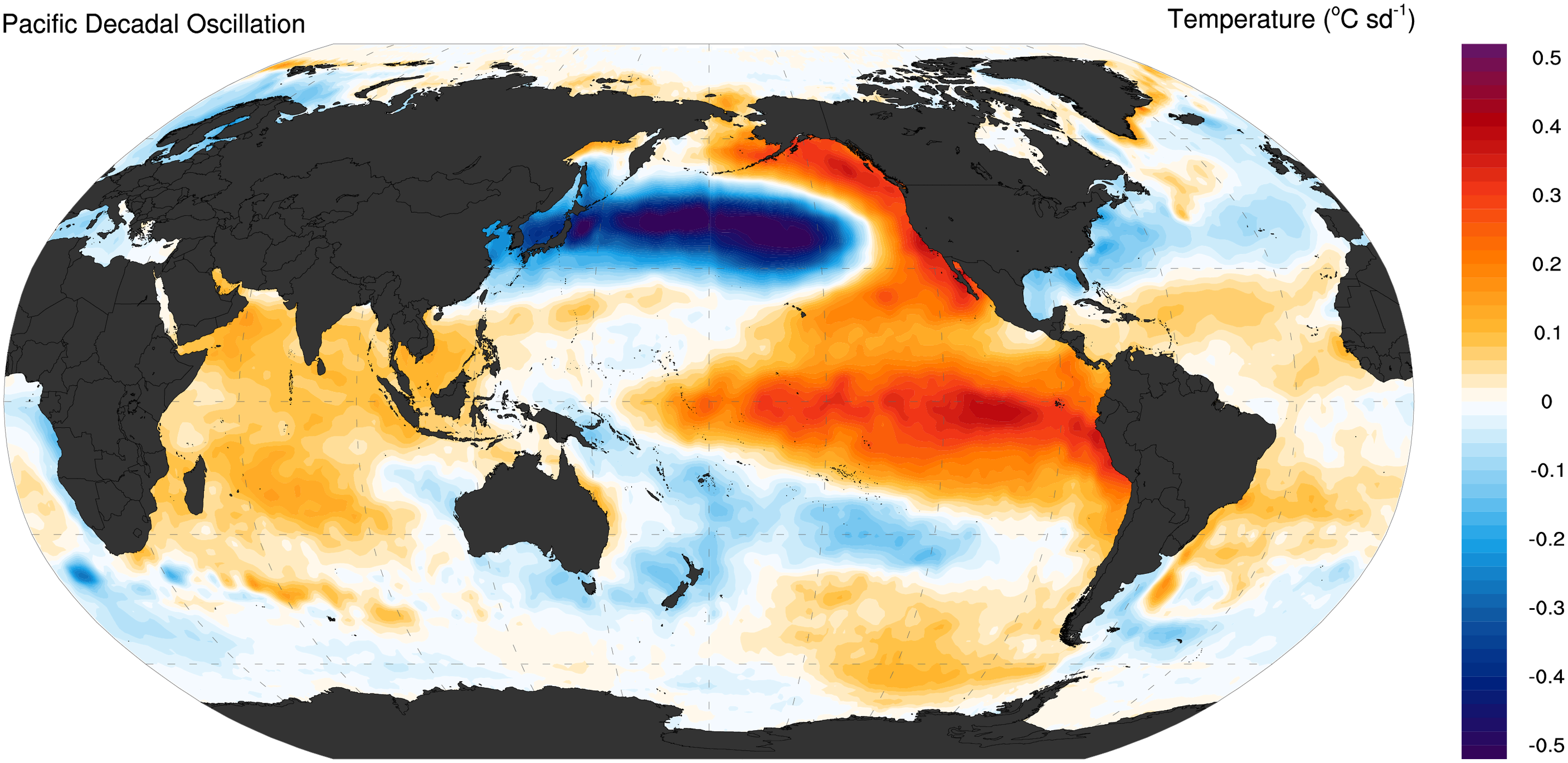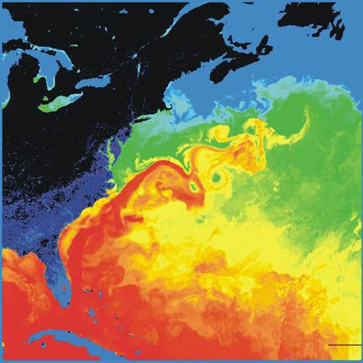|
Arctic Dipole Anomaly
The Arctic dipole anomaly is a pressure pattern characterized by high pressure on the arctic regions of North America and low pressure on those of Eurasia. This pattern sometimes replaces the Arctic oscillation and the North Atlantic oscillation. It was observed for the first time in the first decade of 2000s and is perhaps linked to recent climate change. The Arctic dipole lets more southern winds into the Arctic Ocean resulting in more ice melting. The summer 2007 event played an important role in the record low sea ice extent which was recorded in September. The Arctic dipole has also been linked to changes in arctic circulation patterns that cause drier winters in Northern Europe, but much wetter winters in Southern Europe and colder winters in East Asia, Europe and the eastern half of North America. Description In the 1990s and early 2000s, many studies of Arctic sea ice export focused on the Arctic and North Atlantic oscillations as the primary drivers of export. How ... [...More Info...] [...Related Items...] OR: [Wikipedia] [Google] [Baidu] |
North America
North America is a continent in the Northern Hemisphere, Northern and Western Hemisphere, Western hemispheres. North America is bordered to the north by the Arctic Ocean, to the east by the Atlantic Ocean, to the southeast by South America and the Caribbean Sea, and to the south and west by the Pacific Ocean. The region includes Middle America (Americas), Middle America (comprising the Caribbean, Central America, and Mexico) and Northern America. North America covers an area of about , representing approximately 16.5% of Earth's land area and 4.8% of its total surface area. It is the third-largest continent by size after Asia and Africa, and the list of continents and continental subregions by population, fourth-largest continent by population after Asia, Africa, and Europe. , North America's population was estimated as over 592 million people in list of sovereign states and dependent territories in North America, 23 independent states, or about 7.5% of the world's popula ... [...More Info...] [...Related Items...] OR: [Wikipedia] [Google] [Baidu] |
Barents Sea
The Barents Sea ( , also ; , ; ) is a marginal sea of the Arctic Ocean, located off the northern coasts of Norway and Russia and divided between Norwegian and Russian territorial waters.World Wildlife Fund, 2008. It was known earlier among Russians as the Northern Sea, Pomorsky Sea or Murman Sea ("Norse Sea"); the current name of the sea is after the historical Netherlands, Dutch navigator Willem Barentsz. The Barents Sea is a rather shallow Continental shelf, shelf sea with an average depth of , and it is an important site for both fishing and hydrocarbon exploration.O. G. Austvik, 2006. It is bordered by the Kola Peninsula to the south, the shelf edge towards the Norwegian Sea to the west, the archipelagos of Svalbard to the northwest, Franz Josef Land to the northeast and Novaya Zemlya to the east. The islands of Novaya Zemlya, an extension of the northern end of the Ural Mountains, separate the Barents Sea from the Kara Sea. Although part of the Arctic Ocean, the Barents Sea ... [...More Info...] [...Related Items...] OR: [Wikipedia] [Google] [Baidu] |
Siberian High
The Siberian High (also Siberian Anticyclone; (''Aziatsky antitsiklon''); zh, 西伯利亞高壓; Pinyin ''Xībólìyǎ gāoyā''; Kazakh Азия антициклоны (''Aziya antitsiklonı'')) is a massive collection of cold dry air that accumulates in the northeastern part of Eurasia from September until April. It is usually centered on Lake Baikal.“The Siberian High and Climate Change over Middle to High-Latitude Asia” It reaches its greatest size and strength in the when the air temperature near the center of the high-pressure area is often lo ... [...More Info...] [...Related Items...] OR: [Wikipedia] [Google] [Baidu] |
Polar Vortex
A polar vortex, more formally a circumpolar vortex, is a large region of cold, rotating air; polar vortices encircle both of Earth's polar regions. Polar vortices also exist on other rotating, low-obliquity planetary bodies. The term polar vortex can be used to describe two distinct phenomena; the stratospheric polar vortex, and the tropospheric polar vortex. The stratospheric and tropospheric polar vortices both rotate in the direction of the Earth's spin, but they are distinct phenomena that have different sizes, structures, seasonal cycles, and impacts on weather. The stratospheric polar vortex is an area of high-speed, cyclonically rotating winds around 15 km to 50 km high, poleward of 50°, and is strongest in winter. It forms during autumn when Arctic or Antarctic temperatures cool rapidly as the polar night begins. The increased temperature difference between the pole and the tropics causes strong winds, and the Coriolis effect causes the vortex to spin up. T ... [...More Info...] [...Related Items...] OR: [Wikipedia] [Google] [Baidu] |
Pacific–North American Teleconnection Pattern
The Pacific–North American teleconnection pattern (PNA) is a large-scale weather pattern with two modes, denoted positive and negative, and which relates the atmospheric circulation pattern over the North Pacific Ocean with the one over the North American continent. It is the second leading mode of natural climate variability in the higher latitudes of the Northern Hemisphere (behind the Arctic Oscillation or North Atlantic Oscillation) and can be diagnosed using the arrangement of anomalous geopotential heights or air pressures over the North Pacific and North America. On average, the troposphere over North America features a ridge on the western part of the continent and a trough over the eastern part of the continent. The ''positive phase'' of the PNA teleconnection is identified by anomalously low geopotential heights south of the Aleutian Islands and over Southeastern U.S. straddling high geopotential heights over the North Pacific from Hawaii to the U.S. Intermou ... [...More Info...] [...Related Items...] OR: [Wikipedia] [Google] [Baidu] |
Pacific Decadal Oscillation
The Pacific decadal oscillation (PDO) is a robust, recurring pattern of ocean-atmosphere climate variability centered over the mid-latitude Pacific basin. The PDO is detected as warm or cool surface waters in the Pacific Ocean, north of 20°N. Over the past century, the amplitude of this climate pattern has varied irregularly at interannual-to-interdecadal time scales (meaning time periods of a few years to as much as time periods of multiple decades). There is evidence of reversals in the prevailing polarity (meaning changes in cool surface waters versus warm surface waters within the region) of the oscillation occurring around 1925, 1947, and 1977; the last two reversals corresponded with dramatic shifts in salmon production regimes in the North Pacific Ocean. This climate pattern also affects coastal sea and continental surface air temperatures from Alaska to California. During a " warm", or "positive", phase, the west Pacific becomes cooler and part of the eastern ocean warm ... [...More Info...] [...Related Items...] OR: [Wikipedia] [Google] [Baidu] |
Indian Ocean Dipole
The Indian Ocean Dipole (IOD), is an irregular oscillation of sea surface temperatures in which the western Indian Ocean becomes alternately warmer (positive phase) and then colder (negative phase) than the eastern part of the ocean. Phenomenon The IOD involves an aperiodic oscillation of sea-surface temperatures (SST), between "positive", "neutral" and "negative" phases. A positive phase sees greater-than-average sea-surface temperatures and greater precipitation in the western Indian Ocean region, with a corresponding cooling of waters in the eastern Indian Ocean—which tends to cause droughts in adjacent land areas of Indonesia and Australia. The negative phase of the IOD brings about the opposite conditions, with warmer water and greater precipitation in the eastern Indian Ocean, and cooler and drier conditions in the west. The IOD also affects the strength of monsoons over the Indian subcontinent. A significant positive IOD occurred in 1997–98, with another in 2006. T ... [...More Info...] [...Related Items...] OR: [Wikipedia] [Google] [Baidu] |
Gulf Stream
The Gulf Stream is a warm and swift Atlantic ocean current that originates in the Gulf of Mexico and flows through the Straits of Florida and up the eastern coastline of the United States, then veers east near 36°N latitude (North Carolina) and moves toward Northwest Europe as the North Atlantic Current. The process of western intensification causes the Gulf Stream to be a northward-accelerating current off the east coast of North America. Around , it splits in two, with the northern stream, the North Atlantic Drift, crossing to Northern Europe and the southern stream, the Canary Current, recirculating off West Africa. The Gulf Stream influences the climate of the coastal areas of the East Coast of the United States from Florida to southeast Virginia (near 36°N latitude), and to a greater degree, the climate of Northwest Europe. A consensus exists that the climate of Northwest Europe is warmer than other areas of similar latitude at least partially because of the stron ... [...More Info...] [...Related Items...] OR: [Wikipedia] [Google] [Baidu] |
Climate Of Europe
Europe is generally characterized by a temperate climate. Most of Western Europe has an oceanic climate, in the Köppen climate classification, featuring cool to warm summers and cool winters with frequent overcast skies. Southern Europe has a distinctively Mediterranean climate, which features warm to hot, dry summers and cool to mild winters and frequent sunny skies. Central-eastern Europe is classified as having a humid continental climate, which features warm to hot summers and cold winters. The coastal lowlands of the Mediterranean Basin have more of a wet winter and dry summer season pattern, the winter season extends from October to February while the summer season is mainly noticeable in the dry months where precipitation can, in some years, become extremely scarce. A very small area in the continent features the desert climate which exists in the south-eastern coasts of Spain making them the only places in Europe that have an arid climate. Gulf Stream The climate ... [...More Info...] [...Related Items...] OR: [Wikipedia] [Google] [Baidu] |
Beaufort Gyre
The Beaufort Gyre is one of the two major ocean currents in the Arctic Ocean. It is roughly located north of the Alaskan and Canadian coast. In the past, Arctic sea-ice would circulate in the Beaufort gyre up to several years, leading to the formation of very thick multi-year sea-ice. Due to warming temperatures in the Arctic, the gyre has lost an extensive amount of ice, practically turning what used to be a nursery for sea-ice to mature and grow into the thickest and oldest ice of the Arctic Ocean into a "graveyard" for older ice. Dynamical mechanisms Conditions in the Arctic have favored sea ice loss in recent years during the Northern Hemisphere summers. At the end of the 20th century, analyses of increasing Pacific Surface Water temperatures led to the discovery of a connection between these rising temperatures and the onset of severe loss of Arctic sea ice in the Beaufort Sea. A reason for the existence of this link was proposed: "...delayed winter ice formation allows for mo ... [...More Info...] [...Related Items...] OR: [Wikipedia] [Google] [Baidu] |
Atlantic Multidecadal Oscillation
The Atlantic Multidecadal Oscillation (AMO), also known as Atlantic Multidecadal Variability (AMV), is the theorized variability of the sea surface temperature (SST) of the North Atlantic Ocean on the timescale of several decades. While there is some support for this mode in models and in historical observations, controversy exists with regard to its amplitude, and whether it has a typical timescale and can be classified as an oscillation. There is also discussion on the attribution of sea surface temperature change to natural or anthropogenic causes, especially in tropical Atlantic areas important for hurricane development. The Atlantic multidecadal oscillation is also connected with shifts in hurricane activity, rainfall patterns and intensity, and changes in fish populations. Definition and history Evidence for a multidecadal climate oscillation centered in the North Atlantic began to emerge in 1980s work by Folland and colleagues, seen in Fig. 2.d.A. That oscillation was t ... [...More Info...] [...Related Items...] OR: [Wikipedia] [Google] [Baidu] |
Abrupt Climate Change
An abrupt climate change occurs when the climate system is forced to transition at a rate that is determined by the climate system energy-balance. The transition rate is more rapid than the rate of change of the external forcing, though it may include sudden forcing events such as meteorite impacts. Abrupt climate change therefore is a variation beyond the variability of a climate. Past events include the end of the Carboniferous Rainforest Collapse, Younger Dryas, Dansgaard–Oeschger events, Heinrich events and possibly also the Paleocene–Eocene Thermal Maximum. The term is also used within the context of climate change to describe sudden climate change that is detectable over the time-scale of a human lifetime. Such a sudden climate change can be the result of feedback loops within the climate system or tipping points in the climate system. Scientists may use different timescales when speaking of ''abrupt events''. For example, the duration of the onset of the Paleoc ... [...More Info...] [...Related Items...] OR: [Wikipedia] [Google] [Baidu] |









